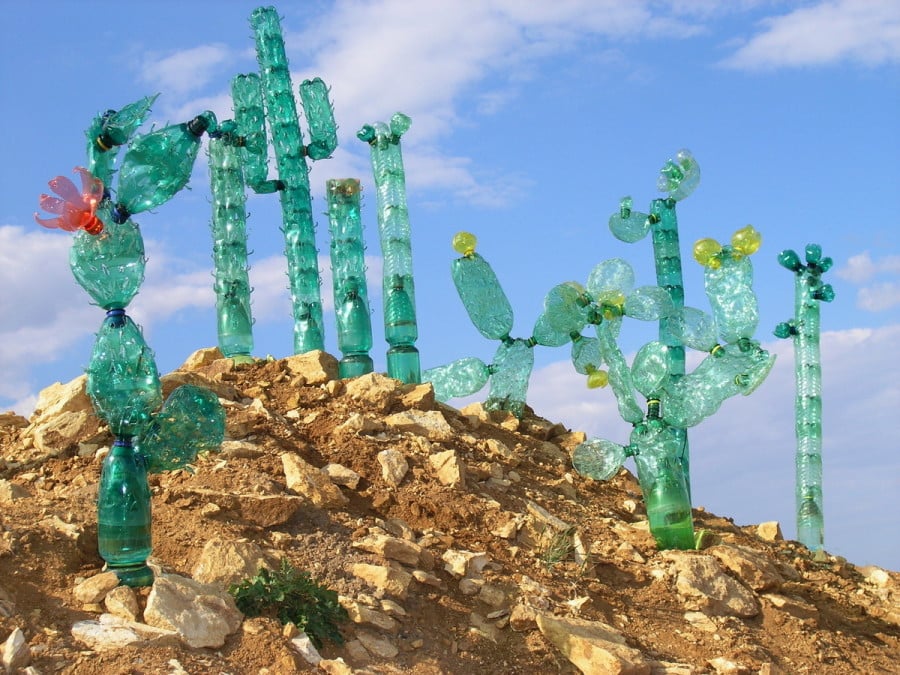
Today, April 22, is Earth Day. Initiated in 1970, Earth Day is a lodestar for the modern environmental movement, which looks to limit humankind’s negative impact on the planet, protecting endangered species and keeping our air and water clean. As they do with so many other important issues, many artists embrace the environmental cause in their work, doing their part for the earth. In honor of the holiday, artnet News has rounded-up some contemporary environmentally-themed works, many of which you may not be familiar with. Enjoy!
Some of the trash sorted by Joshua Sofaer for “The Rubbish Collection” at London’s Science Museum.
Photo: Katherine Leedale.
1. Joshua Sofaer’s “The Rubbish Collection”
Last summer, British artist Joshua Sofaer spent a month collecting all the trash produced by visitors and staff at London’s Science Museum. The result was an environmental awareness-focused exhibition titled “The Rubbish Collection,” an almost-beautiful, yet soberingly large gallery display culled from some 33 tons of garbage—a staggering reminder of the amount of waste in our society.
Mary Miss, Greenwood Pond: Double Site,
Des Moines. Photo: Judith Eastburn, courtesy the Cultural Landscape Foundation.
2. Mary Miss’s Greenwood Pond: Double Site
An important work by environmental artist Mary Miss recently received a new lease on life, thanks to the Cultural Landscape Foundation: Greenwood Pond: Double Site (1989–96), an installation in Des Moines that encourages visitors to the Greenwood Pond to become more fully engaged with wetland environment by traversing wooden structures. These observation platforms allow visitors to experience the pond from a variety of different vantage points.
Theo Jansen, Apodiacula 2
flickr.com
3. Theo Jansen’s “Strandbeests“
Dutch artist Theo Jansen uses water bottles, PVC tubes, and other recycled materials to make his “Strandbeests,” which he then sets free on the beach. The mechanical sculptures harness the power of the wind to lumber along the shore, responding to environmental conditions to avoid the ocean waves and keep from tipping over during strong winds.
Veronika Richterová, “The Collection of Cactuses.”
Photo: Michal Cihlár.
4. Veronika Richterová’s “The Collection of Cactuses”
Czech Republic-based artist Veronika Richterová is a master of the recycling bin, transforming simple plastic soda bottles into beautiful, strangely translucent cactus sculptures. The PET-ART Museum project, ongoing since 2003, currently uses no less than 3,500 plastic bottles from 96 different countries.
Jason deCaires Taylor, Ocean Atlas, in the new Sir Nicholas Nuttall Coral Reef Sculpture Garden. Photo: Jason deCaires Taylor.
5. Jason deCaires Taylor’s Ocean Atlas
For Jason deCaires Taylor, the environmental aspect of his art lies not so much in the materials—used and sustainable though they are—but in the purpose the works serve. Over time, Taylor’s submerged sculptures are gradually transformed into artificial reefs, becoming home to coral and other marine life. He recently created the world’s largest underwater statue—the 60-ton, 18-foot-tall Ocean Atlas—for the Bahamas Reef Environment Educational Foundation.
Sebastião Salgado, A Yali man in the Jayawijaya mountains of Irian Jaya (2010), still from the film The Salt of the Earth; related photograph in “Genesis.” ICP, New York.
Photo: ICP.
6. Sebastião Salgado’s Salt of the Earth
In recent years, social photographer Sebastião Salgado has shifted his focus to the natural world, crisscrossing the globe in search of untouched landscapes. His stunning images of remote Siberia, the African savanna, and the Amazon show the rich variety of life on this planet, and serve as a reminder of the utmost importance of environmental conservation. This photo, taken in Indonesia’s West Papua province, seems almost abstract in its composition, and depicts one of the isolated Yali people.
Beijing artist Liang Kegang collecting a jar’s worth of fresh French air. Photo courtesy of Liang Kegang.
7. Liang Kegang’s Jar of French Mountain Air
Air pollution is so bad in China that at least one company has literally shipped bags of fresh mountain air to more industrialized areas as a promotional stunt. In a pointed critique of his country’s poor air quality, artist Liang Kegang auctioned off a jar of fresh air from the French countryside to a group of collectors and artists this past year, ultimately fetching $860 for the glass vessel.
Andy Goldsworthy, Five Men, Seventeen Days, Fifteen Boulders, One Wall (2010), Storm King Art Center. Photo: Andy Goldsworth, courtesy Galerie Lelong, New York.
8. Andy Goldsworthy’s Five Men, Seventeen Days, Fifteen Boulders, One Wall (2010)
British sculptor Andy Goldsworthy‘s practice is less about an environmental message, and more about embracing the world’s natural beauty. His site-specific work transforms everything from sticks and stones to vibrantly-colored fall leaves into art. Many of these pieces are short-lived, but the Storm King Art Center in New Windsor, New York, boasts an impressively long, winding stone wall created by Goldsworthy without the assistance of concrete.
Simon Beck, snow drawing in Aletsch Arena in Switzerland.
Photo: Simon Beck.
9. Simon Beck’s Snow Art
Another artist who employs elements of the environment in creating gorgeous yet ephemeral artworks, Simon Beck (who we previously pegged as an artist to look into during the ultimately underwhelming snowstorm that hit New York back in January) draws massive, intricate patterns in the snow, tirelessly trekking through empty fields to add a human element to an already-stunning natural scene. Here, an enormous work created by Beck last month in the Swiss village of Bettmeralp is dwarfed by the majesty of the surrounding mountains.
Agnes Denes, rendering of The Living Pyramid (2015).
10. Agnes Denes’s Living Pyramid
Agnes Denes‘s Living Pyramid may still be a work in progress, but we couldn’t help including one environmental work to look forward to. The piece, scheduled to open at Queens’s Socrates Sculpture Park on May 17, will add a giant earth structure to the city skyline, covered in grass and flowers that will bloom throughout the summer season.